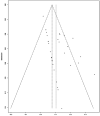Meta-analysis of postoperative antithrombotic therapy after left atrial appendage occlusion
- PMID: 33249962
- PMCID: PMC7708721
- DOI: 10.1177/0300060520966478
Meta-analysis of postoperative antithrombotic therapy after left atrial appendage occlusion
Abstract
Objective: This meta-analysis explored the safety and effectiveness of different anticoagulant regimens after left atrial appendage occlusion (LAAO).
Methods: Databases, such as PubMed, MEDLINE, EMBASE, Web of Science, and Cochrane Library, were searched to identify eligible studies according to the inclusion criteria. The incidences of events, including device-related thrombus (DRT) formation, stroke, systemic thromboembolism, bleeding, cardiovascular mortality, and all-cause mortality, were analyzed using R version 3.2.3.
Results: The screening retrieved 32 studies, including 36 study groups and 4,474 patients. The incidence of outcomes after LAAO was calculated via meta-analysis. In the subgroup analysis, the rates of DRT formation, cardiovascular mortality, and all-cause mortality were significantly different among different antithrombotic methods. Single antiplatelet therapy was associated with the highest rate of adverse events, followed by dual antiplatelet therapy (DAPT). Vitamin K antagonists (VKAs) and new oral anticoagulants (NOACs) carried lower rates of adverse events.
Conclusions: Anticoagulant therapy had better safety and efficacy than antiplatelet therapy. Thus, for patients with nonabsolute anticoagulant contraindications, anticoagulant therapy rather than DAPT should be actively selected. NOACs displayed potential for further development, and these treatments might represent alternatives to VKAs in the future.
Keywords: Left atrial appendage occlusion; antiplatelet therapy; antithrombotic strategies; device-related thrombus; meta-analysis; oral anticoagulant; vitamin K antagonist.
Conflict of interest statement
Figures




Similar articles
-
Network Meta-Analysis of Initial Antithrombotic Regimens After Left Atrial Appendage Occlusion.J Am Coll Cardiol. 2023 Oct 31;82(18):1765-1773. doi: 10.1016/j.jacc.2023.08.010. Epub 2023 Aug 21. J Am Coll Cardiol. 2023. PMID: 37611779
-
Comparative Efficacy and Safety of Low-Dose Direct Oral Anticoagulants Versus Dual Antiplatelet Therapy Following Left Atrial Appendage Occlusion in Patients With Nonvalvular Atrial Fibrillation: A Systematic Review and Meta-Analysis.Catheter Cardiovasc Interv. 2025 May;105(6):1311-1319. doi: 10.1002/ccd.31461. Epub 2025 Feb 20. Catheter Cardiovasc Interv. 2025. PMID: 39980323
-
Short-term antithrombotic strategies after left atrial appendage occlusion: a systematic review and network meta-analysis.Front Pharmacol. 2023 Sep 1;14:1159857. doi: 10.3389/fphar.2023.1159857. eCollection 2023. Front Pharmacol. 2023. PMID: 37719867 Free PMC article. Review.
-
Antithrombotic therapy after left atrial appendage occlusion.Expert Rev Cardiovasc Ther. 2025 Apr;23(4):141-152. doi: 10.1080/14779072.2025.2486154. Epub 2025 Apr 3. Expert Rev Cardiovasc Ther. 2025. PMID: 40151884 Review.
-
Short-Term Antiplatelet Versus Anticoagulant Therapy After Left Atrial Appendage Occlusion: A Systematic Review and Meta-Analysis.JACC Clin Electrophysiol. 2020 May;6(5):494-506. doi: 10.1016/j.jacep.2019.11.009. Epub 2020 Jan 29. JACC Clin Electrophysiol. 2020. PMID: 32439033 Free PMC article.
Cited by
-
Incidence and predictors of device-related thrombus after left atrial appendage closure with Watchman device.Postepy Kardiol Interwencyjnej. 2024 Jun;20(2):164-171. doi: 10.5114/aic.2024.140315. Epub 2024 Jun 5. Postepy Kardiol Interwencyjnej. 2024. PMID: 39022721 Free PMC article.
-
Impact of chronic kidney disease on left atrial appendage occlusion: A meta-analysis of procedural outcomes and complications.Medicine (Baltimore). 2024 Jul 19;103(29):e38935. doi: 10.1097/MD.0000000000038935. Medicine (Baltimore). 2024. PMID: 39029071 Free PMC article.
-
Percutaneous Left Atrial Appendage Closure With a Novel LAA Occluder for Stroke Prevention in Atrial Fibrillation.JACC Asia. 2022 Sep 6;2(5):547-556. doi: 10.1016/j.jacasi.2022.04.009. eCollection 2022 Oct. JACC Asia. 2022. PMID: 36518725 Free PMC article.
-
Short-term antiplatelet versus anticoagulant therapy after left atrial appendage closure: a systematic review and meta-analysis.J Thromb Thrombolysis. 2024 Feb;57(2):194-203. doi: 10.1007/s11239-023-02919-2. Epub 2024 Jan 5. J Thromb Thrombolysis. 2024. PMID: 38180590
-
Left Atrial Appendage Occlusion and Post-procedural Antithrombotic Management.J Clin Med. 2024 Jan 30;13(3):803. doi: 10.3390/jcm13030803. J Clin Med. 2024. PMID: 38337496 Free PMC article. Review.
References
-
- Kirchhof P, Benussi S, Kotecha D, et al. 2016 ESC Guidelines for the management of atrial fibrillation developed in collaboration with EACTS. Eur Heart J 2016; 37: 2893–2962. - PubMed
-
- Chow DHF, Wong YH, Park JW, et al. An overview of current and emerging devices for percutaneous left atrial appendage closure. Trends Cardiovasc Med 2019; 29: 228–236. - PubMed
-
- Turagam MK, Parikh V, Afzal MR, et al. Replacing warfarin with a novel oral anticoagulant: Risk of recurrent bleeding and stroke in patients with warfarin ineligible or failure in patients with atrial fibrillation (The ROAR study). J Cardiovasc Electrophysiol 2017; 28: 853–861. - PubMed
-
- Holmes DR, Jr, Alkhouli M, Reddy V. Left Atrial Appendage Occlusion for The Unmet Clinical Needs of Stroke Prevention in Nonvalvular Atrial Fibrillation. Mayo Clin Proc 2019; 94: 864–874. - PubMed
-
- John Camm A, Colombo A, Corbucci G, et al. Left atrial appendage closure: a new technique for clinical practice. Heart Rhythm 2014; 11: 514–521. - PubMed
Publication types
MeSH terms
Substances
LinkOut - more resources
Full Text Sources
Medical
Miscellaneous

